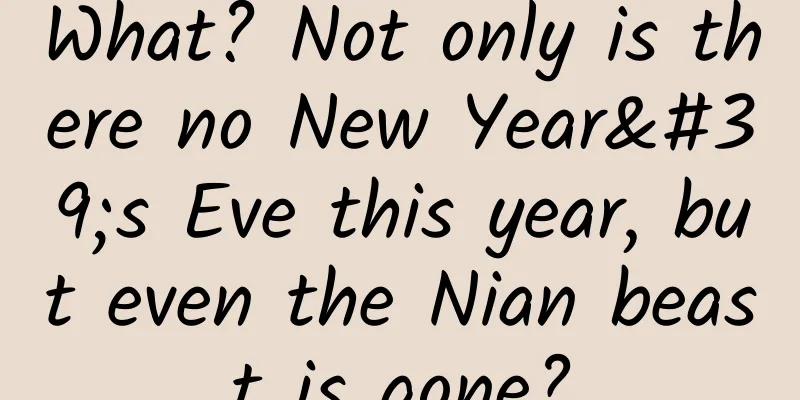What? Not only is there no New Year's Eve this year, but even the Nian beast is gone?

|
Whenever the Lunar New Year approaches, the legend of the "Nian Beast" is mentioned again. In many people's minds, it is a myth that can be traced back to ancient times. The most widely circulated version is as follows: According to legend, there was a ferocious monster called "Nian" which usually lived on the bottom of the sea. On the last day of every year, it would crawl ashore to eat people and then leave on the first day of the new year. The "Nian Beast" in picture books is usually drawn in a shape similar to a dancing lion | Katie Chen/Wikimedia Commons Every family dared not sleep on New Year's Eve, and had to eat a sumptuous New Year's Eve dinner, because it might be the last meal in their life. On the first day of the New Year, everyone dared to go out to visit relatives and friends to celebrate that they were not eaten by the Nian beast. This is the origin of the word "New Year". Or is this the true face of the underwater "Nian Beast"? | BenduKiwi / Wikimedia Commons Later, under the guidance of a mysterious old man, people finally knew that the "Nian Beast" was afraid of noise and the color red, so they set off firecrackers, chopped dumpling stuffing, hung red lanterns, and posted Spring Festival couplets and blessing characters at the gate on New Year's Eve to scare the beast away. From then on, there was the custom of eating dumplings, hanging lanterns, posting couplets, and setting off firecrackers during the New Year. The legend of the Nian beast is not as old as imagined If you think about it carefully, there are actually quite a few bugs in this story. Even if you don't consider the time when paper and gunpowder appeared, just the fact that you have to eat dumplings during the Chinese New Year is something that our friends in the south will not accept. There is also a derivative version in which the man-eating monster is called "Xi", so the last day of the year is called "Chuxi", which means to get rid of the monster. (According to this logic, if people decide to fight with "Xi", wouldn't this day be called "Pinxixi"?) In fact, the legend of the "Nian Beast" only appeared in modern times, and the academic community has done quite detailed research on its origin. According to Zhu Chunxiang's article "Exploring the Origin of the Nian Beast Legend", the earliest record of the "Nian Beast" that can be found was found in the newspaper "Diamond Diamond" in the early 1930s. An article signed by "Haishang Shushisheng" mentioned that the author had seen New Year paintings with the theme of "Purple Star" when he was a child: “Purple Star Shining” New Year painting rubbing (partial) | Chen Jian / Hong Kong Baptist University Library Art Collections "Whenever the painter painted a stone pillar, he would lock a beast that looked like a dog but was not a dog on the pillar. Some said that the beast was the star Tiangou, while others said that the beast was named Nian and that it always wanted to eat people, so the star Ziwei locked it." This story was widely spread with the help of modern media, and details were constantly added, eventually becoming a "new folk legend" recognized by modern people. The true origin of "Chinese New Year" The oracle bone script of "Nian" is an image of a person carrying ears of wheat on his back. This represents its original meaning: "Nian is the name of the ripe wheat. It ripens once a year, so it is used as the name of the year." The oracle character for "year" As a major agricultural country, our ancestors regarded the sowing, ripening and storage cycles of grains as important time units. "Er Ya Shi Tian" records the division of time periods before the Zhou Dynasty: "Xia called it Sui, Shang called it Si, Zhou called it Nian, Tang and Yu called it Zai", "Sui refers to the movement of the Jupiter, Si refers to the end of the four seasons, Nian refers to the harvest of grains, and Zai refers to the end of things and the beginning of a new beginning." "Chinese New Year" can be traced back to the ancient "La Festival", which was a grand ceremony to celebrate the harvest and worship the eight agricultural gods when the old year replaced the new year. At the end of the year, there is another important sacrificial activity, the "La Festival". "La means to worship ancestors, and La means to report to all gods", so the last month of the year is named "Layue". After the Han Dynasty, the two were basically combined. According to legend, Confucius's disciple Zigong lamented that the whole country was obsessed with the wax festival, but he did not see any fun in it. Confucius' answer became the source of a famous idiom in later generations: "Relaxation and tension are the way of civil and military affairs." The "civil and military" here refer to King Wen and King Wu of the Western Zhou Dynasty, not the "civil and military both accomplished" as we say today. What needs to be driven away is the "epidemic ghost", not the "Nian beast" In ancient times, in addition to offering sacrifices, the ritual of "driving away the plague ghosts" was an indispensable activity during the twelfth lunar month, also known as "Dan Nuo". The main plot of the "Nian Beast" legend is actually a variation of this ritual. Eastern Han Dynasty figurine of Fang Xiang | Sailko / Wikimedia Commons The host of the ceremony is called "Fang Xiang", who was originally a deity in ancient mythology who drove away plague ghosts and mountain and river monsters. Later, it evolved into an official position that presided over the ceremony of driving away plague and warding off evil spirits. In the ceremony, his appearance is "covered with bear skin, four golden eyes, black clothes and red skirt, holding a spear and raising a shield." The tomb guardian deity in the mural of Xu Xianxiu's tomb in the Northern Qi Dynasty is said to be Fang Xiang | Wikimedia Commons Fang Hongjian, the hero of Qian Zhongshu's novel Fortress Besieged, once complained about his father naming his grandson "Fang Feixiang": "In The Investiture of the Gods, there are two ghosts who lead the way. The elder one is called Fang Bi and the younger one is called Fang Xiang. Fang Feixiang's name seems to be arguing with his ghost brother." From the Zhou Dynasty to the Tang Dynasty, the main form of the palace Nuo ceremony did not change much. It was led by the Prime Minister and the "侲子", a team of boys aged between twelve and sixteen, who ran between the palaces holding peach wood bows and reed arrows, shouting to drive away the plague. The exorcism team in the Tang Dynasty palace was quite large, including 500 demons wearing masks and red skirts, 12 deacons wearing red clothes and carrying hemp whips, as well as ten people each including the Fangxiang, the singing commander, the drum beaters, and the horn blowers. After singing and dancing in the palace, they would kill a rooster at the palace gate and the four city gates to offer sacrifice to the gods. The Great Nuo Tu | The Palace Museum Wang Jian's "Palace Poems" describes "The Jinwu performed Nuo rituals on New Year's Eve, and four teams of people in painted pants and red clothes marched. Lanterns were lit in every courtyard, and people sat under the incense fire and played the sheng." This is a reproduction of the Nuo ritual scene. People burn bamboo in the courtyard, and the sound of the bamboo joints bursting is louder, which is believed to have the effect of scaring away ghosts. The palace exorcism in the Song Dynasty was unprecedented in grandeur, and the structure of the exorcism team also changed. There were no longer Fangxiang, Quzi and deacons. Instead, it was composed of thousands of imperial officials and guards, wearing masks, embroidered clothes, holding golden spears and dragon flags, playing the roles of door gods, judges, Zhong Kui, Zhong Kui's younger sister, land gods, kitchen gods and other gods. Nuo opera | xiquinhosilva / Wikimedia Commons After the Yuan Dynasty, the Nuo rituals hosted by the palace gradually declined and disappeared completely in the Qing Dynasty. However, in many areas of the people, such as Anshun in Guizhou, Nanfeng in Jiangxi, Chizhou in Anhui, and Xiangxi in Hunan, the Nuo rituals still retain a relatively complete custom. The performance is mainly based on singing and dancing with masks. In some places, it is called "Nuo Opera", while in others it is called "Da Ye Hu" or "Zhong Kui Dance". In addition, the Nuo exorcism ritual has also been introduced to the Korean Peninsula, Japan, and Vietnam within the Chinese character cultural circle. The Yoshida Shrine Nuo Festival scene from the Japanese "Miyazawa no Nagata" | Wikimedia Commons Songpa Sandaeo, Korea | Wikimedia Commons During the Vietnamese New Year, flagpoles are erected to ward off evil spirits, and lime is sprinkled on the ground below the poles to form a bow and arrow shape, which may be a remnant of the custom of exorcising evil spirits | Wikimedia Commons There are so many ghosts in China, who is the “epidemic ghost”? Since the Han Dynasty, the choirs would sing the "Ghost Eating Song" during the palace Nuo ceremony. Its main purpose was to scare away the plague ghosts and warn them that if they didn't run away quickly, they might become food for the divine beasts: "Jia is the food (evil and evil), Xiewei eats tigers, Xiongbo eats ghosts, Tengjian eats bad luck, Lanzhu eats misfortune, Boqi eats dreams, Qiangliang and Zuming eat the dead and parasites, Weisui eats Guan, Cuoduan eats giants, Qiongqi and Tenggen eat poison. Let the twelve gods chase the evil and evil, and burn your body, pull your body, cut your flesh, and pull out your lungs and intestines. If you don't leave quickly, the latter will be your food!" The "Ode to the Eastern Capital" further gives the types of plague ghosts that are driven away: "Discard the demons, kill the mad beasts, chop off the snakes, and make the brains good. Imprison the farmer in the cold, and drown the Nüba in the sacred lake. Destroy the Kui, the Xie, and the Wangxiang, kill the Yuzhong, and annihilate the Youguang." Among them, Chimei is the god of mountains and marshes, Xiankuang is an evil ghost, Weishe is as big as a wheel hub, Fangliang is the god of grass and marshes, Gengfu and Nvba are drought ghosts, Kuixia and Wangxiang are wood and stone spirits, and Yuzhong and Youguang are also ghosts that harm the human world. Although almost all of them come from the imagination of the ancients, some of them may also have real prototypes, such as "Kui". Mandrill | m66roepers/Wikimedia Commons One explanation of Kui is "Kui, one-legged, Yue people called it Shansong". "Shansong" is also written as "Shansao" or "Shanxiao", but it is not the same as Mandrillus sphinx, an animal of the genus Mandrill in the family Monkey. This type of mandrill is native to Africa. In terms of sequence, the "mandrill" in ancient legends appeared first, and it was only in modern times that this word was used to name this peculiar-looking monkey. The mandrills described in ancient books are "more than a foot long, naked to catch shrimps and crabs. When they see people staying overnight, they roast shrimps and crabs by the fire at night." "They are found in Lingnan, with one foot and a reversed heel, and three-branched hands and feet. The females like to apply makeup. They build nests in big trees." They are probably primates distributed in southern my country, such as the crab-eating macaque (Macaca fascicularis). The "one foot" may be an illusion caused by the monkey's tail hanging down when it perches on a tree. Crab-eating macaque | Pradeep717 / Wikimedia Commons In addition, another more common description of "Kui" is "shaped like an ox, with a blue body and no horns, and one foot. When it goes out, there will be wind and rain, and its sound is like thunder. Huangdi got it and used its skin to make drums, and the sound could be heard for 500 miles." The "Kui pattern" in cultural relics is generally similar to dragon pattern, which is more similar to reptiles. Therefore, some people think that "Kui" may be a crocodile, and "one foot" refers to the thick tail, and "when it goes out, there will be wind and rain" reverses the cause and effect. It is the crocodile that moves when there is wind and rain, not its activities that bring wind and rain. There is also a more imaginative version. Because the "Classic of Mountains and Seas" records that Kui is located in Liubo Mountain in the East China Sea, 7,000 miles away, which is relatively close to the current Oceania, some people actually put forward the view that "Kui" is actually a kangaroo in the eyes of our ancestors. Not only does its head look a bit like a cow, but its well-developed hind limbs and jumping movements will make people mistakenly think it has "one foot". "Kui" in "Complete Collection of Ancient and Modern Books" | Wikimedia Commons The grey kangaroo does fit the description | PanBK / Wikimedia Commons The reason why the legend of the "Nian Beast" crushed various "epidemic ghosts" and became the mainstream "explosive item" is not only related to the development of modern paper media, but also because of the turbulent society and the people's livelihood in modern times. People felt deeply "difficult at the end of the year", so there was a general recognition of the horror of the "Nian Beast". Author: Yaohua Editor: A Dun This article comes from the Species Calendar, welcome to forward If you need to reprint, please contact [email protected] |
<<: Why does Chang'e-5 adopt a "relay" method for sample return?
>>: "It was amazing! I saw food coming from the ceiling"
Recommend
LG Efficient Test Course 2021
LG High Efficiency Test Course 2021 Resource Intr...
How much does it cost to join the Shangrao Timber Mini Program? What is the price for joining Shangrao Timber Mini Program?
How much does it cost to join a wood mini program...
Mango Internet TV review experience: Mango HiQ 5II has good performance
Nowadays, TV manufacturers, mobile phone manufactu...
8 golden marketing ideas, use them!
Ever wondered how companies like Apple or Nike be...
A table to solve the eating problem of "high blood sugar patients"
At the beginning, please do two multiple-choice q...
How does a new media director write a promotion plan?
Today’s topic is how to write a promotion plan fo...
The Great Emperor of Heaven and Earth: Emperor Wu of Han
" Amazing King of Heaven and Earth: Emperor W...
It's already the coldest time of the year, why aren't all the major ice rinks in Beijing open yet? Is this really a "warm winter"?
Review expert: Ye Haiying, deputy director of the...
Tesla is once again rumored to be building a factory in China and is accelerating its pace after meeting with the Vice Premier
According to foreign media reports, people famili...
Warning: Never put frozen food back into the refrigerator after thawing!
During the Spring Festival holiday, you may have ...
Is it really enough for Tencent to position itself as an assistant in the smart car industry?
At the Tencent 2018 Global Partner Conference hel...
Photographing the Tiangong Palace around the world丨You photographed the Tiangong Palace and Wang Yaping photographed you
"The wind is biting cold, It can't stop ...
LG G3 first-hand experience: amazing/perfect
It is rumored that LG G3 is a performance monster....
Zhang Haiyin's 50 psychological case videos
Course Catalog: ├──Courseware | ├──50 Case Studie...
Ginkgo nuts are ripe. Some say they are poisonous, while others say they are beneficial. Do you know how to eat them in the safest way?
Ginkgo trees are tall and straight, with fan-shap...









